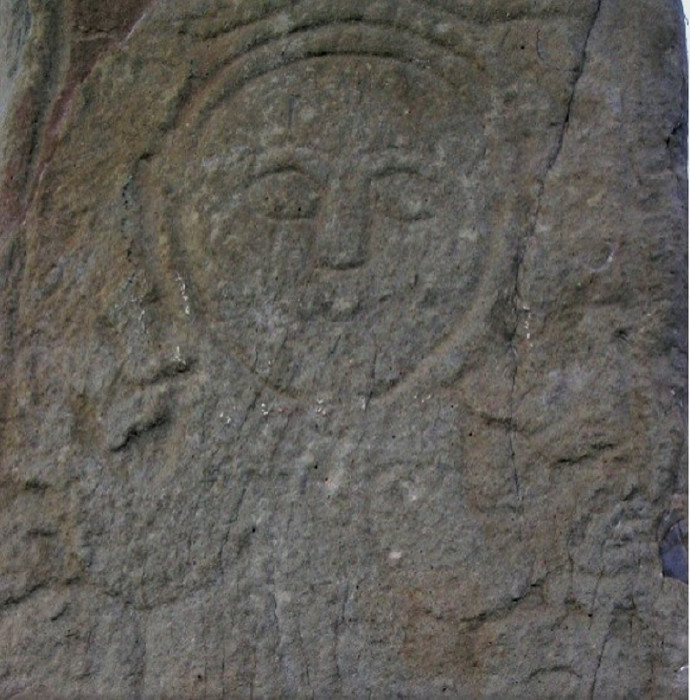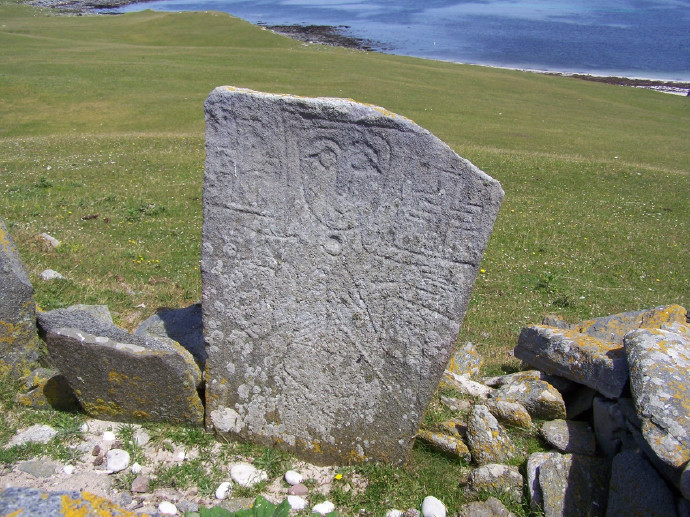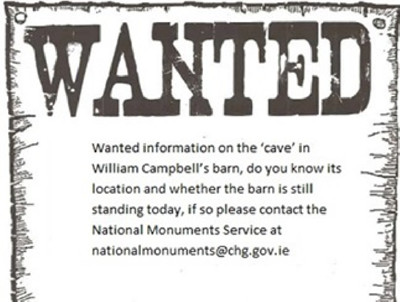Bishop in a Boat
An example of Naïve Art from North Donegal inscribed onto a prehistoric cup-marked stone
SMR number DG011-065001-, Carndoagh, Co. Donegal (view in Historic Environment Viewer)
Rock-scribing: Marks deliberately incised or cut into a stone surface. They can vary from a series of very fine lines to geometric patterns or anthropomorphic images. They occur principally on rock outcrops, boulder shelters, caves and megalithic tombs. The date of rock scribings is uncertain though some may be prehistoric. These carvings incorporate motifs that do not regularly fit within the accepted canon of prehistoric Passage tomb art or Rock art.

Cup-marked (DG011-065002-) bedrock with image of a bishop in a boat beneath (DG011-065001-)
Naïve art is a term used to describe a style of painting, sculpture or carving which is produced by a person who has not been formally trained as an artist. The term ‘primitive’ is mistakenly used sometimes instead of naïve to describe art which is characterised by a perspective that is often simplistic or childlike in its appearance. This is an art style which can be interpreted as having its origins in the prehistoric period and it is possible to imagine the adjoining panel of non-figurative pre-historic rock art as the first example of naïve art carved in Co. Donegal. This art style carries on into the early Christian period with the childlike incised figures carved onto the High Cross (DG011-035009-) and the adjoining stone pillars (DG011-035010-/011-) at Carndonagh.

High Cross, Carndonagh, Co. Donegal (DG011-035009-)
At Carndoagh a panel of rock outcrop decorated with prehistoric up-marks and naïve art was identified by Bauke Roof and reported to the Archaeological Survey of Ireland in 2015. The rock rises above poorly drained land with a stream running past marking the townland boundary between Straths and Carndoagh. From the top of the rock there are good views of Trawbreaga Bay to the north. An earth-fast boulder decorated with prehistoric art (DG011-065----) lies 3m to the south. The rock outcrop protrudes from the northern edge of a low cliff face, forming a small cave or rock shelter, looking out towards Trawbreaga Bay. The surface of the rock outcrop contains two prehistoric cup marks (DG011-065002-) located at the top of the stone. Beneath these cup marks one can see the faint outline of an incised figure wearing a conical cap with some letters carved to the left of the head. The naïve figure with its childlike expression consists of a bishop holding a crosier standing in a boat with the letters of his name carved above his head on the left hand side. The carving dates from the middle of the 18th century but the style of carving is reminiscent of the naïve faces carved onto early Christian cross-slabs and pillar-stones. The carving of a childlike face with slightly humorous expression is similar to the carved face of the crucified Christ figure on the early Christian Crucifixion slab (MA023-014005-) on the Bailey Mór of Inishkea North, Co. Mayo.

Early Christian crucifixion slab, Inishkea North, Co. Mayo (MA023-014005-)
Folklore collected in 1937 from nearby Glasalt [Treanfasy] School records the local story which explains the meaning behind the carving of Bishop John McColgan (1702-65) in a boat. The story goes as following; ‘It was in Carndoagh. Bishop McColgan hid in the Penal Days. The cave can be seen under the floor in Willie Campbell's barn, Joseph Campbell [a Presbyterian] great grand-father to Willie loosed the horses out of the plough and took him away in time. When the soldiers came and looked in the cave and saw he was gone they said "The nest is warm but the bird is gone". He left him over at Leenan [near Claggan] and he got a boat there that left him at Fanad, Co. Donegal. The bishop said that as long as there would be a Campbell in Carndoagh he would have good luck’ (The Schools’ Collection, Volume 1116, Pages 90-1; www.duchas.ie). This local folktale relates to the Roman Catholic Bishop of Derry, John McColgan, who was born in Cregamullen [Straths Td.], Clonmany, on the Inishowen peninsula in 1702. He was ordained a priest in 1730 and lived at Muff, Co. Donegal. In 1752 he was appointed Bishop of Derry. The Bishop was persecuted by the British authorities during the Penal Times, he was offered temporary refuge with Joseph Campbell who lived in Carndoagh and who organized the safe transport of Bishop McColgan out of the county by means of a boat which took him to Fanad. He died in Omagh, Co. Tyrone on the 21st of December 1765 and was buried in Clonca graveyard (DG012-002011-).

Images: Archaeological Survey of Ireland and courtesy of Bauke Roof
Tionscadal digitithe Chnuasach Bhéaloideas Éireann, ceann de na cnuasaigh bhéaloidis is mó ar domhan

